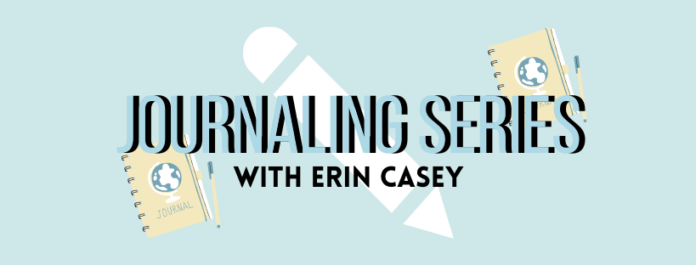As we look at ways to “Live in the Now,” we asked author, blogger, and book coach Erin K. Casey to guide us through the benefits of journaling. Her summer series highlights some of the helpful aspects of personal writing. We look forward to hearing how journaling helps you live in the now.
—-
Do you admire innovative business leaders or envy your artistic friends who seem to know exactly how to pull a room or an outfit together, all the while thinking, “I could never do that. I’m just not creative”? If so, you aren’t alone. Almost half of the people in the United States believe they aren’t creative.
Or maybe you fall in line with the other half of the country’s population and believe you are creative, but never seem to have the time or freedom to stretch your artistic wings as often or as widely as you would like. According to a study by Adobe, 62% of self-professed creative Americans believe they aren’t living up to their imaginative potential.
Distractions, productivity demands, and fear of critique or outright rejection are just a few of the things that keep our imaginations caged. That’s unfortunate because creativity is an exceptionally valuable skill. It frees us to consider different perspectives and see new possibilities. It is an essential trait for success at work, in relationships, and it is important to mental and emotional well-being. We owe it to ourselves and society at large to explore and make the most of our creative potential.
And here’s the truth: You are creative.
As young children, we easily tap into our imaginations. After the age of about five or six, however, our creative muscles slowly atrophy. By the time we reach adulthood, those muscles are all but invisible—covered by layers of self-doubt and fear and weakened by disuse.
It may take more work for some people than others to uncover and define those creative muscles, but they’re in there. One way to exercise them is through journaling.
In the first article in this series, I talked about “no-guilt journaling.” The no-guilt aspect comes into play again here as we use journaling to build our creative muscles. I want to offer you two types of journaling exercises to try: free writing and questioning. And there’s no one right way to do either of these exercises, so no pressure and no guilt. Just write and see what you discover.
Free Writing When I was in eleventh grade, I had a wonderful, young, hippie-ish English teacher named Jill. She did a lot of things differently from my other teachers (like telling us her first name). One of the things I learned from her was that it’s fun to write for no reason. She called it free writing. Almost daily, we would grab our spiral journals and write about anything and everything for five minutes. I don’t remember if she read our journals—I tend to think not. What we wrote wasn’t important; the simple act of writing was what mattered. She often had a prompt on the chalkboard (yes, it was a real old-fashioned chalkboard), but we didn’t have to use it. Sometimes what I wrote was as nonsensical as, “Blah, blah, blah, I don’t know what to write, I am just going to keep writing so I look busy.” But other times I wrote about what was going on in my teenage world. I wrote about things that made me happy or sad or angry. Occasionally I wrote short stories or prayers. And by the end of the writing session, I generally felt lighter. It was a pure, stream-of-consciousness exercise that I continue to practice even now.
The point of writing without an agenda or a purpose is that ideas begin to surface that you didn’t know were there. If you write often enough and in the same journal, you can flip through several days’ worth of pages and discover themes or thoughts to explore further.
Free writing is simple! Try it for five to ten minutes several days in a row. You might be surprised by what your imagination comes up with when you write about nothing—and everything.
Questioning What’s the worst that could happen if . . . ? Why do I want to . . . ? How can I be more . . . ? Why is it so hard to break my habit of . . . ?
Journals are a place for reflection, a space to consider questions that you may not want to discuss aloud. Asking and answering meaningful questions and probing deeper with why, how, what if, and what else challenges your imagination to consider different angles of a problem or a goal.
Sooner or later, just like those dot-to-dot pictures you completed in elementary school, your thoughts start to connect and form new ideas.
Consider how questioning could prove valuable to your business: Maybe you, like so many other people, have been hit with a huge loss due to COVID-19. Journaling about how you feel helps you process the emotions. That’s good, but don’t stop there. Ask hard questions like what is the worst that could happen? Ask your brain for ideas by posing questions like what if I did XYZ differently? Questions like these will push your imagination to consider new or revised options that just may help you connect the dots between where you are now and where you would like to see your business go.
If you ask and re-ask questions as part of a regular journaling practice, you will train your brain to think differently—more creatively.
Sometimes what creativity needs is a safe place to grow and develop. It needs a place where anything is possible and where no one is going to critique or criticize underdeveloped ideas. Your journal is that space. Start writing and see where the ideas take you.
Sources:
https://www.adobe.com/aboutadobe/pressroom/pdfs/Adobe_State_of_Create_Global_Benchmark_Study.pdf
https://ideapod.com/born-creative-geniuses-education-system-dumbs-us-according-nasa-scientists/
